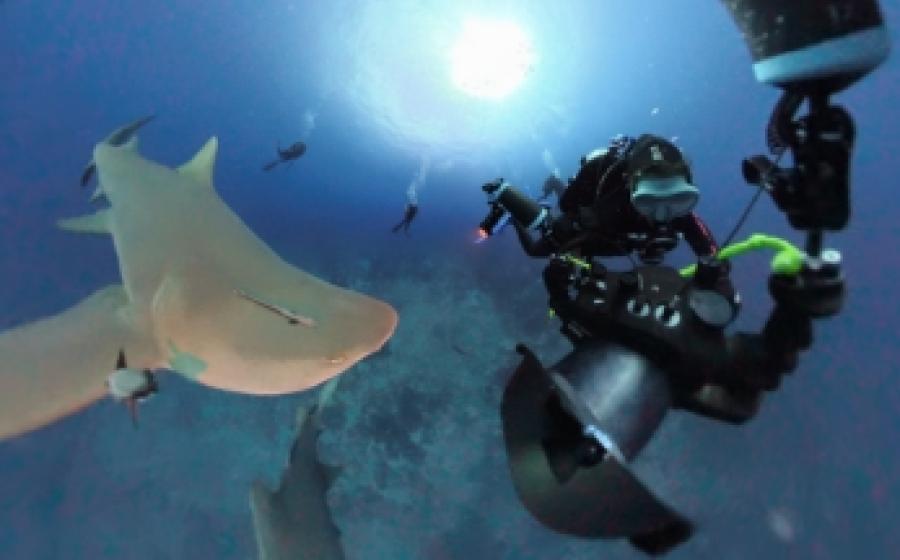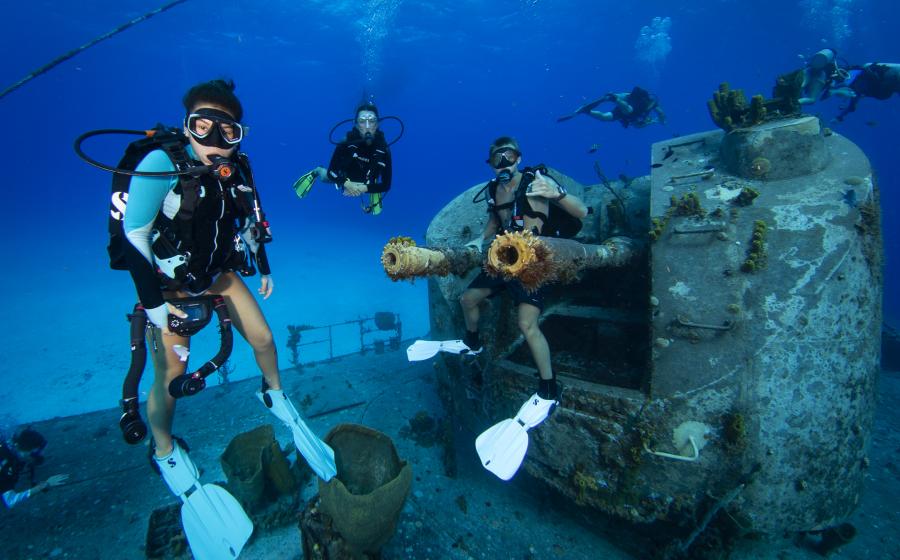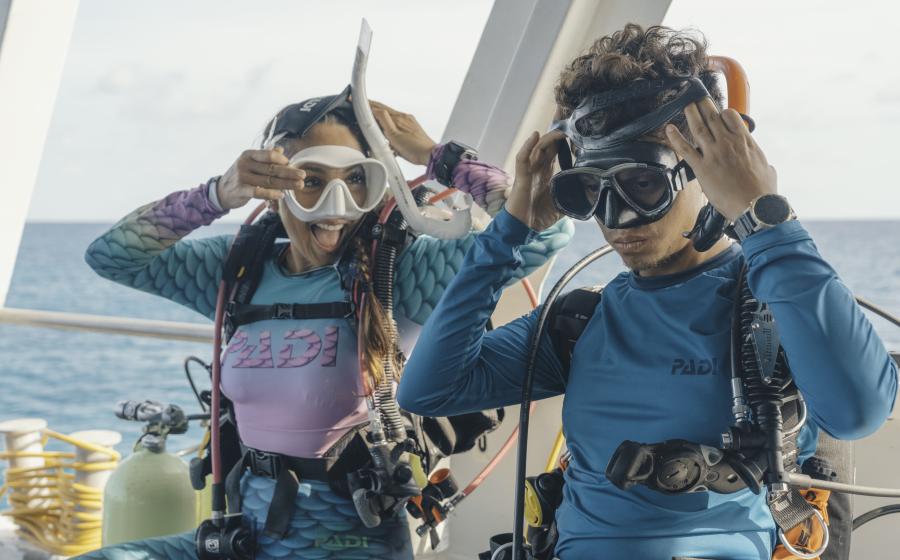Fear of Flooding

February 2008
Text and Photography by Stephen Frink
A flooded camera is one of the most traumatic experiences an underwater photographer will ever face, and if you stay in the game long enough, it's bound to happen--probably more than once. It's always a gut-wrenching experience, but the first time is definitely the worst. When I broke the seal, literally, I was diving in a ripping current. I knew I would have a hard time jumping in and swimming back to the boat to retrieve my camera, so I went in holding the system. The side of the lens slapped the surface of the water, the mount tweaked to one side and saltwater splashed past the O-ring--not a lot of water, but it doesn't take much to ruin your day. I didn't complete my assignment that day, but worse, I was just starting out as a photographer and could barely afford the $200 repair bill.
Today's housings for digital cameras are far more robust and reliable, but they can flood too, often with devastating results. And never mind the $200 repair cost--modern electronic cameras are landfill fodder if they take a significant saltwater hit.
Accidents do happen, but an ounce of prevention can save you pounds of cash. Here's my advice for preventing and dealing with a flooding event:
Prevent
A little double-checking could have prevented the pictured flood. The main O-ring for the housing popped out of its groove and was actually visible outside the housing when it went into the water, making this disaster unavoidable once the camera hit the ocean. What went wrong?
The photographer (not me--this time anyway) got distracted as he was closing the housing and made a painful mistake.
Do all pre-dive prep in a clean, well-lit environment, and give it 100 percent of your attention. Engaging in casual chitchat or listening to the dive briefing during your setup invites disaster.
Inspect all O-rings before seating a port or closing the back of a housing. If you wear glasses, by all means, wear them for this task!
Use the right O-ring grease. The silicone, viton or other material that goes into making the O-ring is optimized for a particular kind of grease. If you use Nikonos grease on Ikelite, Sea and Sea or Inon O-rings, they will likely swell, increasing their chances of crimping outside the groove. The Seacam viton O-ring will take almost any kind of grease, but Seacam's grease is formulated to be "sticky," helping the O-ring stay in place. It is all very confusing and fraught with peril if the wrong choice is made, so stick with the manufacturer's recommendations. Also, be aware that not every O-ring requires grease. Some are essentially gaskets, rather than sealing surfaces, that have to slide within a cylinder or shaft. Reading the owner's manual can save considerable grief later on.
Always do a 360-degree visual inspection of the exterior of the housing to make sure no O-rings extrude.
Test the housing by submerging it in the freshwater rinse bucket on the dive boat. Are bubbles percolating from the housing? If so, you've got a flood, and catching it there minimizes the submersion time and the amount of water that intrudes. Also, any water that does get inside will be fresh, not salt, increasing your chances of saving the camera and lens.
Have someone hand you the housing once you're in the water rather than jumping in with it. The force of the water slapping against a dome port or other seating surface can cause a flood. Remember, most housings seal best with a little water pressure applied, and on the water's surface or in rinse tanks, housed cameras are surprisingly vulnerable--handle with care.
You are responsible for your own flood-prevention initiatives. In the earlier story, the crew handing the camera to the photographer didn't notice the extruded O-ring. While it would've been a happy accident if they had, the crew was not responsible for checking the camera.
Preserve
A misplaced O-ring or a dislodged port will create a calamitous flood, inundating both camera and lens, but floods are often caused by something less obvious--a strand of hair or bit of detritus stuck to an O-ring. Ikelite's clear Lucite housings make it possible for you to see the flood and where the leak is coming from. The best aluminum housings have moisture alarms to alert you to any intrusion. Unfortunately, alarms won't tell you how fast the water is coming in, and you'll be tempted to get out of the water quickly. If you suspect there's water in your housing:
Don't blow your safety stop. Whatever is happening inside the housing has probably already happened. Inform your buddy, cut your dive short, but don't ignore a prudent hang-time in a panic to get the camera to the surface.
Keep it totally upright. Most housings have a fair bit of room below the camera table, and if the water pools there, it may never even touch the camera. At the very least, this boosts the odds of your lens surviving. Keep the camera level all the way to the surface, and tell the crew to avoid sloshing it about as they carry it to the camera table.
Open carefully. Have towels handy to sop up the water. If the camera is dry, put it in a safe place. Displacing saltwater with fresh is usually the best first aid for a housing, especially when it's done immediately. If it's a massive flood, give the housing a freshwater rinse (inside and out), avoiding electrical components like the wiring for the hotshoe. If there's a battery in the moisture alarm, remove it first. For a light saltwater intrusion, merely blot dry and dab the affected surfaces with a cloth dampened with freshwater.
Dry thoroughly. Even after the massive flood caused by the extruded O-ring, I had the housing ready to go back in the water in less than 15 minutes. Unfortunately, there wasn't another camera body to go in it.
Backup
A spare camera body is pragmatic preparation for a flood; it's also good for topside use while the camera is inside the housing. Some shooters house smaller, cheaper digital systems for this very reason. Housings are very specific in terms of control placement, so you'll likely need the exact same model as a backup should a flood, or other accident, befall your primary.
Insure
I can't speak for all camera insurance companies, but when I suffered a recent flood, I had camera insurance with Divers Alert Network (www.h2oinsurance.com), and the service was amazing. The flood happened on a Wednesday, and by Friday, I had a request for documentation of whether the camera and lens could be repaired (not!). On Saturday I emailed my supporting documentation, and incredibly, I heard back from the agent the same day. By Monday morning, a check had been issued and sent in the mail!
Some insurance companies offer depreciated replacement value on camera equipment. In this case, I paid premiums based on a certain replacement cost, and I was issued a check at that price, minus the $100 deductible. The replacement camera I bought was newer and better than the one I'd lost, no surprise since it was several years farther along the digital evolutionary trail. While this didn't lessen the angst and disappointment of seeing my beloved D-SLR dripping saltwater all over the boat deck, it did make getting back into the action a lot less painful!

February 2008
Text and Photography by Stephen Frink
A flooded camera is one of the most traumatic experiences an underwater photographer will ever face, and if you stay in the game long enough, it's bound to happen--probably more than once. It's always a gut-wrenching experience, but the first time is definitely the worst. When I broke the seal, literally, I was diving in a ripping current. I knew I would have a hard time jumping in and swimming back to the boat to retrieve my camera, so I went in holding the system. The side of the lens slapped the surface of the water, the mount tweaked to one side and saltwater splashed past the O-ring--not a lot of water, but it doesn't take much to ruin your day. I didn't complete my assignment that day, but worse, I was just starting out as a photographer and could barely afford the $200 repair bill.
Today's housings for digital cameras are far more robust and reliable, but they can flood too, often with devastating results. And never mind the $200 repair cost--modern electronic cameras are landfill fodder if they take a significant saltwater hit.
Accidents do happen, but an ounce of prevention can save you pounds of cash. Here's my advice for preventing and dealing with a flooding event:
Prevent
A little double-checking could have prevented the pictured flood. The main O-ring for the housing popped out of its groove and was actually visible outside the housing when it went into the water, making this disaster unavoidable once the camera hit the ocean. What went wrong?
The photographer (not me--this time anyway) got distracted as he was closing the housing and made a painful mistake.
Do all pre-dive prep in a clean, well-lit environment, and give it 100 percent of your attention. Engaging in casual chitchat or listening to the dive briefing during your setup invites disaster.
Inspect all O-rings before seating a port or closing the back of a housing. If you wear glasses, by all means, wear them for this task!
Use the right O-ring grease. The silicone, viton or other material that goes into making the O-ring is optimized for a particular kind of grease. If you use Nikonos grease on Ikelite, Sea and Sea or Inon O-rings, they will likely swell, increasing their chances of crimping outside the groove. The Seacam viton O-ring will take almost any kind of grease, but Seacam's grease is formulated to be "sticky," helping the O-ring stay in place. It is all very confusing and fraught with peril if the wrong choice is made, so stick with the manufacturer's recommendations. Also, be aware that not every O-ring requires grease. Some are essentially gaskets, rather than sealing surfaces, that have to slide within a cylinder or shaft. Reading the owner's manual can save considerable grief later on.
Always do a 360-degree visual inspection of the exterior of the housing to make sure no O-rings extrude.
Test the housing by submerging it in the freshwater rinse bucket on the dive boat. Are bubbles percolating from the housing? If so, you've got a flood, and catching it there minimizes the submersion time and the amount of water that intrudes. Also, any water that does get inside will be fresh, not salt, increasing your chances of saving the camera and lens.
Have someone hand you the housing once you're in the water rather than jumping in with it. The force of the water slapping against a dome port or other seating surface can cause a flood. Remember, most housings seal best with a little water pressure applied, and on the water's surface or in rinse tanks, housed cameras are surprisingly vulnerable--handle with care.
You are responsible for your own flood-prevention initiatives. In the earlier story, the crew handing the camera to the photographer didn't notice the extruded O-ring. While it would've been a happy accident if they had, the crew was not responsible for checking the camera.
Preserve
A misplaced O-ring or a dislodged port will create a calamitous flood, inundating both camera and lens, but floods are often caused by something less obvious--a strand of hair or bit of detritus stuck to an O-ring. Ikelite's clear Lucite housings make it possible for you to see the flood and where the leak is coming from. The best aluminum housings have moisture alarms to alert you to any intrusion. Unfortunately, alarms won't tell you how fast the water is coming in, and you'll be tempted to get out of the water quickly. If you suspect there's water in your housing:
Don't blow your safety stop. Whatever is happening inside the housing has probably already happened. Inform your buddy, cut your dive short, but don't ignore a prudent hang-time in a panic to get the camera to the surface.
Keep it totally upright. Most housings have a fair bit of room below the camera table, and if the water pools there, it may never even touch the camera. At the very least, this boosts the odds of your lens surviving. Keep the camera level all the way to the surface, and tell the crew to avoid sloshing it about as they carry it to the camera table.
Open carefully. Have towels handy to sop up the water. If the camera is dry, put it in a safe place. Displacing saltwater with fresh is usually the best first aid for a housing, especially when it's done immediately. If it's a massive flood, give the housing a freshwater rinse (inside and out), avoiding electrical components like the wiring for the hotshoe. If there's a battery in the moisture alarm, remove it first. For a light saltwater intrusion, merely blot dry and dab the affected surfaces with a cloth dampened with freshwater.
Dry thoroughly. Even after the massive flood caused by the extruded O-ring, I had the housing ready to go back in the water in less than 15 minutes. Unfortunately, there wasn't another camera body to go in it.
Backup
A spare camera body is pragmatic preparation for a flood; it's also good for topside use while the camera is inside the housing. Some shooters house smaller, cheaper digital systems for this very reason. Housings are very specific in terms of control placement, so you'll likely need the exact same model as a backup should a flood, or other accident, befall your primary.
Insure
I can't speak for all camera insurance companies, but when I suffered a recent flood, I had camera insurance with Divers Alert Network (www.h2oinsurance.com), and the service was amazing. The flood happened on a Wednesday, and by Friday, I had a request for documentation of whether the camera and lens could be repaired (not!). On Saturday I emailed my supporting documentation, and incredibly, I heard back from the agent the same day. By Monday morning, a check had been issued and sent in the mail!
Some insurance companies offer depreciated replacement value on camera equipment. In this case, I paid premiums based on a certain replacement cost, and I was issued a check at that price, minus the $100 deductible. The replacement camera I bought was newer and better than the one I'd lost, no surprise since it was several years farther along the digital evolutionary trail. While this didn't lessen the angst and disappointment of seeing my beloved D-SLR dripping saltwater all over the boat deck, it did make getting back into the action a lot less painful!






